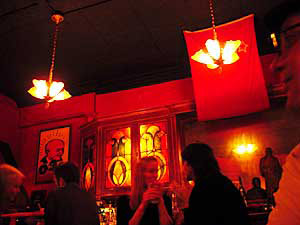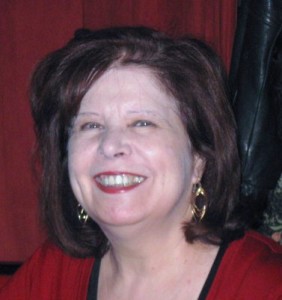When you copy many sources it’s research – or today’s Scroll.
(1) Exhibit #27,837 that science fiction fandom has gone mainstream:
Sasquan is in Alaska Airlines magazine, the copies distributed on Horizon flights! Online at http://t.co/GLFdHSMIac . Bottom of page 9.
— sasquansf (@sasquansf) August 17, 2015
(2) The renovated Clifton’s Brookdale Cafeteria, where LASFS once met, reopens September 17.
In its prime [in the 1930s] the Brookdale served close to 10,000 people a day, and Clinton went on to open ten more cafeterias, among them the Polynesian-themed Pacific Seas, where a two-story waterfall greeted customers at the entrance and every 20 minutes rain fell over the mezzanine. Clinton’s wondrous environments are said to have inspired everyone from Walt Disney to writer Ray Bradbury, animation pioneer Ray Harryhausen, and Scientology founder L. Ron Hubbard, who gathered at the Brookdale for meetings of the newly formed Los Angeles Science Fantasy Society.
“This is a total playground,” Meieran told me, digging into a crumbling box of old metal nameplates he had just discovered in a corner. “When I get into a project, I love to tear it apart. The first night I get a screwdriver and a hammer and I start opening things.”
Linda Dishman, executive director of the Los Angeles Conservancy, consulted with Meieran on how to overhaul the building while being mindful of its history. “You want somebody who respects what it is—you don’t want somebody who is going to strip that away,” she says. “But then you don’t want somebody to go ‘Clifton’s crazy,’ either. Andrew did a fabulous job. He took spaces that had not been included in the restaurant and made them into a Clifton’s for this century.”
(3) And when they weren’t at Clifton’s, Joseph Hawkins has a theory about how some LASFSians were spending their time. This theory has been around for awhile, but Hawkins’ version sounds nicer than Laney’s.
The stories and commentary in these journals served as incubators for ideas that would lead to political organizing decades later. Sci-fi allowed readers to safely engage with thoughts about alien races with mixed genders or finding love despite their differences. In the 1930s, these messages were actually more overt; by the McCarthy era, the culture’s atmosphere had stifled messages about gay or lesbian themes.
“You have to read between the lines,” Hawkins said. Publications like Weird Tales or other “creature magazines” often featured monsters carrying off nude women — and were being illustrated by female artists. The same was true for some illustrations featuring men. Considering the artists’ sexual backgrounds lends a different context to who these clichéd monsters represented — one that says more about life on Earth than anywhere else.
In the days before the Internet, sci-fi magazines also served as an early precursor to discussion forums. Readers traded letters about space exploration as well as changes in society. They even trolled one another, igniting epic arguments about politics and other subjects.
The readers in these circles include a who’s who of classic sci-fi: Ray Bradbury, Robert Heinlein and the omni-present L. Ron Hubbard were all highly active. So was superfan Forrest Ackerman, publisher of Famous Monsters of Filmland.
But just like Internet forums, most people wrote using nom de plumes, allowing them to express a side of themselves that was often kept hidden. Kepner himself had about 14 different pseudonyms ranging from esoteric references to unprintable humor.
Some gay and lesbian writers had entire alter egos to go with their names. One of those writers was “Lisa Ben” — an anagram of “lesbian” — who worked as a Warner Bros. secretary and used company equipment to print the first lesbian zine in the United States. But she also was known as Tigrina the Devil Doll, a kind of proto-Catwoman with her own handmade costume.
All those pseudonyms make for intensive detective work. Hawkins and others at ONE Archives have had to sleuth out who is who and what the relationships were between everyone. Those skills are vital to archival research, he said, and have helped to uncover unexpected connections between sci-fi and LGBT communities across the country, and even internationally.
(4) Nancy Kress, guest blogging at Women in Science Fiction, talks about the ultimate sources of stories in “Why This? Why There? Why Now? Or Why I Wrote Crossfire. Maybe”.
So what does all this have to do with science fiction, and specifically with my novel Crossfire? SF writers may name the inspiration for their works (AI research, the battle for Iwo Jima, Star Trek, a dream about ghosts), but that only identifies the rocks and beaches on the surface. Most fiction comes from shifting tectonic plates far underground, throwing up fire and lava from everything the writer has ever experienced. This is what gives fiction depth (and scholars something to write about). Sometimes, even the author is surprised by what emerges from his or her keyboard.
(5) Earl Hamner fans have created a Change.org petition calling for him to receive Kennedy Center honors.
Earl Hamner not only gave us The Waltons but he brought us Falcon Crest and several episodes of The Twilight Zone. He also brought us the animated adaption of Charlotte’s Web (1973 film). He produced great Novels like; Fifty Roads to Town (1953), Spencer’s Mountain (1961), You Can’t Get There From Here (1965), The Homecoming: A Novel About Spencer’s Mountain (1970), and Generous Women: An Appreciation (2006). He also gave us great TV movies like; Heidi (1969), Appalachian Autumn (1969), Aesop’s Fables (1971), The Homecoming (for CBS, 1971), Where the Lilies Bloom (1972), The Gift of Love: A Christmas Story (1983) and more! These are just some of the reasons Mr. Hamner should be an Honoree. We the undersigned call on you to honor Mr. Hamner in 2016 with this WAY OVER DUE recognition!
Go to the Kennedy Center Website and submit Earl’s name directly to them for 2016. Do this even if you have already signed the petition and/or if you submitted for 2015. Look for the button that says “Recommend an Honor“. Click that button and fill out the form.
Join our Facebook Group: Make Earl Hamner Jr a 2016 Kennedy Center Honoree
(6) Keith Kato, President of The Heinlein Society, participated in the latest Take Me To Your Reader Podcast.
Seth was lucky enough to get Keith Kato of the Heinlein Society on the phone to chat about the Society, R.A.H. himself, his work, rumors of future adaptations, and even some tidbits about Predestination, which the Pounders discussed earlier in 2015 and is probably still their favorite episode.
(7) Vox Day in “Negotiation” lists whose skulls “we would be willing to accept in order to bring about a rapprochement in science fiction.”
I believe it is a priori apparent that their skulls would be of far more utility to mankind if they were helping satiate the thirst of the Dark Lord and his guests than any other purpose for which they might be currently used.
Of course you do.
(8) It’s Dave Freer’s turn at Mad Genius Club today – see how you score on “Quizz kid”.
10) Do you believe that comments that disagree with you should be censored, or disemvoweled? a) Yes. We’re protecting the freedom of speech and expressing tolerance. How can we do that if just any old redneck can say what he thinks? We’re looking for a vibrant diversity of opinion just like ours. You won’t get that if you let the scum talk. They need to be deprived of a platform, any platform! b) No. Give them a fair crack of the whip at least. Ask ‘em to be civil, maybe. And if they can’t be they can go and spout it somewhere else.
I believe in quoting exactly what they say. Which is why they can’t stand me.
(9) Have you heard? Someone filed a lawsuit against meal replacement company Soylent because it may contain ingredients it shouldn’t.
(10) What actual science fiction fan can’t think of an answer to this question?
https://twitter.com/TJaneBerry/status/633459482475925504
[Thanks to Jamoche, Michael J. Walsh, and John King Tarpinian for some of these stories. Title credit goes to File 770 contributing editor of the day Cubist.]




